-
Posts
1,759 -
Joined
-
Last visited
Content Type
Profiles
Forums
Store
Help Articles
Posts posted by Wholemeal Crank
-
-
A glass teapot is probably not the best choice, but it is lighter and would be less prone torust than a tetsubin, more compact than any metal one I've seen, and quite inexpensixe to replace should it break. I'd love one made of lexan for something like this. I have a variety of tea balls but they don't generally allow enough room for full expansion of a good amount of tea, or if they do, they're too large too fit in a mug, much less the mouth of a thermos
-
did not yet have a chance to try it. But I have just received my first shipment from norbu tea, got it just as I was leaving for the weekend, and will have some nice pu-erhs on which to try it. I have steeped many teas 3, 4, 5 times, but am intrigued by the '30 times or more' I have seen written in reference to some of them, and doubt I can get to that number without either brewing such a tiny amount that I can drink each infusion in one sip; or doing it across two days.
-
I'm trying to figure out what is a good, practical kit for traveling with my own tea. For me this means being able to make at least a pint of tea to carry with me in my backpack for drinking through the day when in meetings etc, where the teas provided, if any are at all, are usually exactly the sort of english breakfast teas I dislike.
I love my little electric kettle that I use at work, but it's a one liter size, and I can't find any that are much smaller than that. I'd really like to have a one pint size, and I've seen some electric mugs but those mostly seem to heat rather than boil the water. I also have used an immersion heater coil plus a pyrex measuring cup, but the dedicated electric kettles are quicker and faster.
I have a lovely inexpensive glass teapot with built-in strainer at the spout, so no need for an infuser.
And a small tupperware or ziploc bag can hold a few days' worth of one tea.
What I want is a small kit like a toiletries kit that will hold this stuff, protect the glass teapot from airport baggage gorillas, and live in the suitcase at all times, ready to add tea and go.
-
I am worried that the older generation will not teach the younger generation how to roast Anxi oolongs traditionally. This is really an art that is best learned by apprenticeship...
That is exactly my fear--that my first love in tea would vanish completely. Already it is not so easy to find, and the random tins and samples I've bought from various sources when I could not get my hands on it were not the same. And when I did find it again this time, the same tin of the same brand was cheaper than I expected, which makes me worry that it might indeed be getting less popular and less profitable, which would put its future at risk. This is one of the reasons I am trying to educate myself more about tea--so I'm less dependent on the one brand from one place.
-
Too late, did that already, but did omit the corn syrup.
And realize now that I should have crisped the cookies in that low oven completely before adding the glaze, and letting the glazing & glaze drying steps be separate.
-
That's a great start on answering my questions.
So....the next step would be to consider my anxi ti guan yin vs the very green appearing ti guan yin on your site--both are ti guan yin, but given how different they look, I have to assume they will taste very different.
How far away can the tea get from the original style and still be called ti guan yin? As long as it is from the same plant? Same county? and still more oolong than green tea?
And are the newer lighter roasted styles taking over now? Is there much grumbling about the loss of traditional darker roasted teas if so?
(obviously, these are questions best discussed over a few pots of the teas in questions, in a tea house in a pleasant garden....)
-
Note to self: need cups that hold at least as much as the gaiwan, but not so large that the gaiwan only fills it a quarter of the way.
-
I just made a pot of Pouchong yesterday for my afternoon tea, and was struck by how strongly it resembles the Taiwan Alishan High Mountain Oolong we're tasting over in another topic. The things I like best about both of them are the same--a warm, grassy, vegetal flavor without bitterness and a floral undertone to the aroma. I'd like to do a head to head comparison, but have to wait a couple of days for my Alishan to arrive in the mail from Norbu Tea, so I compared it to my Ti Kuan Yin.
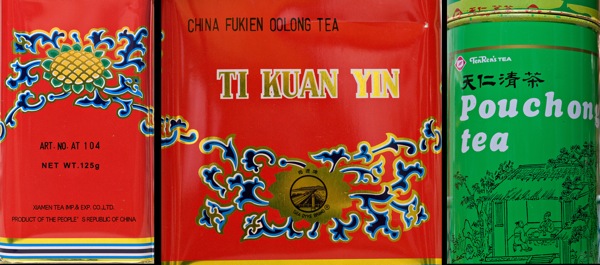
It looked quite different, twisted leaves instead of curled balls, with a color is nearly as dark as my Ti Kuan Yin
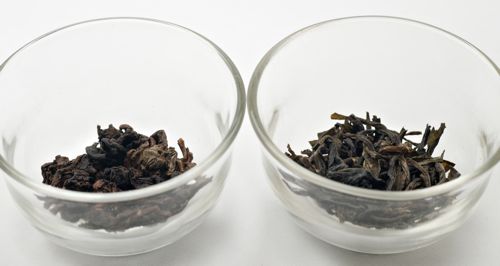
But the tea is about the same shade as the Alishan Oolong, paler and less red than the Ti Kuan Yin
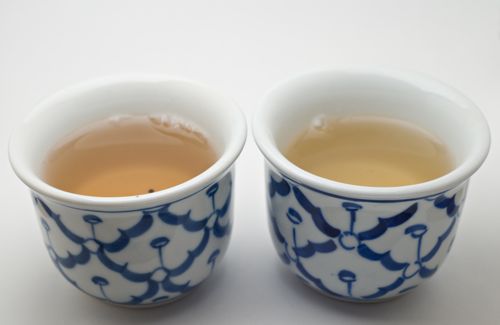
and that brings up the question: what is the difference between pouchong and oolong, and is the similar taste a result of similar processing, or of different techniques being used to achieve a similar flavor profile?
And now I'm intensely curious about the green ti kuan yin that I also ordered from Norbu Tea.
-
When I need to make tea fast, when I've only got five minutes before I have to go to clinic, I get heated water from the water cooler, steep some tea in it for 2 minutes, and dilute it with enough hot water to fill my quart thermos. Most days I take a little more care with water temperature and time than that, but not a whole lot more. Just an electric kettle to heat the water, a teapot, my tea, and the thermos.
I'm having fun playing with the idea of gongfu, the flavor changes with multiple infusions and different steeping times, but don't ever see that being my daily thermos o'tea. It will be for times when I have time, and want to play with a new tea. It's an opportunity to add enjoyment, not an obligation to do it every day.
I'm finding that the really nice teas stand up to the abuse of the quick and dirty, but that's not all that they can do.
-
good point about the bitterness of green teas and unglazed pots--I was pretty sure that would be the answer for the jasmine, but not about the greens in general.
For work I will stick to my glass pot(s), as simplest and most practical.
But may play with some more simple yixings for pus and oolongs at home. It will add some fun to my next trip to the tea shop.
-
will try straight lemon juice and powdered sugar plus a bit of corn syrup, plus drying in a warm oven for a few hours.
-
Some images from my first test brewing
Before brewing--I'm guessing this is about 4 grams of the tea?
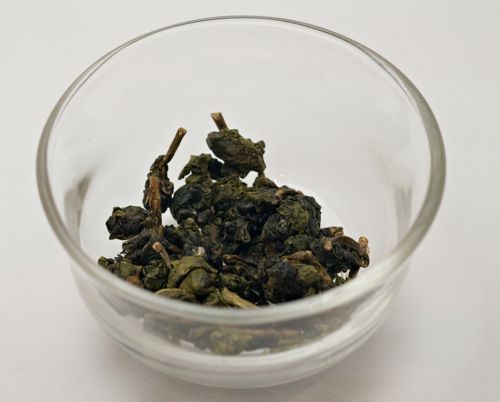
After rinsing--looks like such a tiny amount in that vast pot.....

I poured off a little sample at one minute of the first infusion (water 193 degrees), quite light in color but quite pleasing aroma and flavor

At 2 minutes, the color is stronger
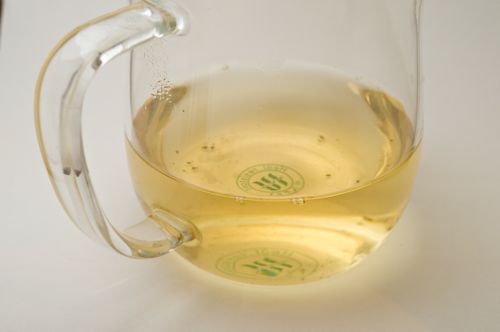
a 3 minute 2nd infusion is again a bit darker
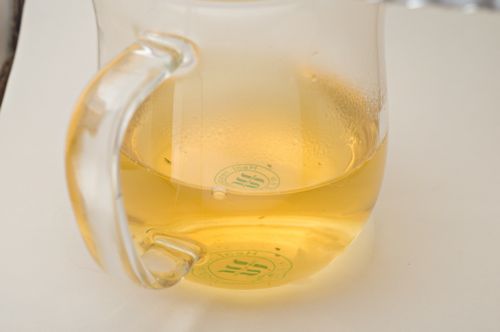
and the leaves have now nearly filled the pot after being fully expanded
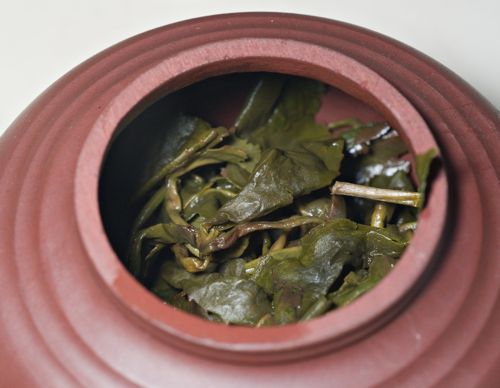
3rd infusion, 4 minutes
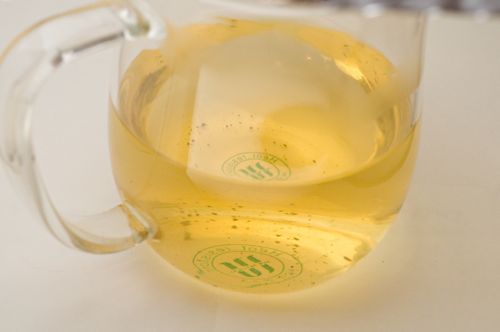
4th infusion, 3 minutes
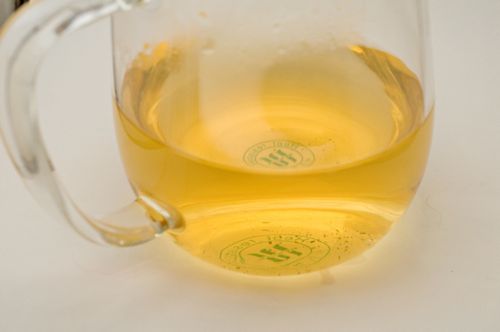
And a final view of the tea leaves, giving a nice idea of the leaves plucked
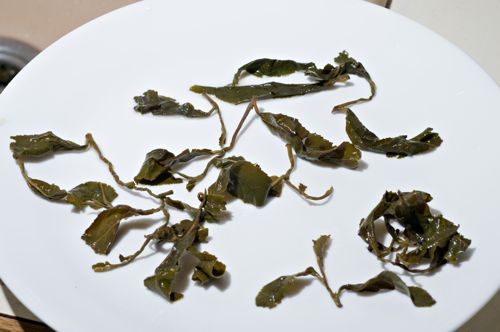
-
I've had those once--that may be where I first got the idea for using a lemon glaze on these.
-
But in general I don't include the pour time when jotting times down.
That's what I would have guessed.
I am finding it works best if I adjust the angle of the lid on the gaiwan before I begin the pour, so that I'm not trying to adjust it while holding it up. But if I guess wrong, it is quite slow.
It should get better as I practice.
-
I am enjoying a thermos full of Pouchong tea from Ten Ren this afternoon. It's a bit tricky to correlate the in-store labels and prices with the web versions--in the store the tins are labelled by $/lb, and on the web site by grade and $/4 oz pkg, but I think this is the one I'm drinking:
which reminds me very much of the taiwain alishan oolong we're tasting in the other topic--very vegetal and light and warm flavored, with almost no bitterness. It looks quite different--the leaves are extended and spindly instead of almost rolled like the other--but the things I like best about them both are the same.
Now wondering more about the relationship between Pouchong and Oolong: how close are the 'green' oolongs to pouchongs?
-
Today made some lovely pouchong tea in the little glass pot, that I brought with me to work. It works as well as the clay pot, but is more practical for the variety of teas I have here and the limited space.
-
One question comes up as I contemplate the very short brewing times suggested for the truest gongfu experience: how do you adjust the brewing time when the leaves are to steep for 20 seconds and it takes 15 to 20 seconds to drain the gaiwan or teapot? Do you consider that part of the steep time or not?
-
And thanks for the good ideas about the glaze. I wonder if making it thinner last time--because I wanted it really lemony, and I just substituted lemon juice for hte milk--made the problem worse.
Maybe a thicker glaze, spread on after baking, and more drying time before attempting to store them might do it.
That, plus I can try adding lemon oil or zest to the dough. I think that will also be nice but not provide the same flavor/texture contrast I'd like to get--what I'm reaching for is more like the crunchy glaze on those commercial cookies that EmilyR mentioned.
-
A long time ago I came up with a recipe for a ginger cookie based on one my Dad remembered from when he was a kid. It is a simple ginger cookie that is not very sweet, finished with simple vanilla glaze.
The last time I made it I got inspired and added a lemon glaze made with lemon juice instead of the water or milk. They were terrific, and disappeared even faster than the chocolate mint cookies based on Hermes' Korova Cookies from Paris Sweets. The problem: the glaze makes them hard to store, being prone to sticking when they're stacked.
So....I'd like a less sticky solution for a simpler to handle cookie.
I've tried putting on a light coat of glaze before they're baked, which just makes for a crackly fractured top and alters baking times quite a bit.
I've tried brushing it on after they're baked and then returning them to the oven with the temp down to 200 degrees for a few minutes to try to dry out the glaze.
Each worked a little but not very well.
And i thought about putting the lemon in the cookies, but can't see adding enough lemon juice to the recipe without unbalancing it, and that would avoid the nice contrast between ginger cooking and lemon topping.
Is this problem why the sandwich cookie was invented?
-
I am loving the little pot just posted above, and understand that traditionally these are kept one per type of tea.
To what level of detail do most of you try to go with that--
would the same teapot for green and white teas be stretching it too far?
what about green/white vs yellow teas?
and should the light Taiwain oolong we just tasted be ok in the same pot as some basic anxi ti kuan yin?
green tea with green tea with jasmine?
Just curious.
And then, how do you keep track of which pot is which?
I can easily see keeping track of 'plain pot with dots on the spout' is for oolong, 'decorated pot with dragon on side' is for pu-erh, but beyond that, they might need to be labelled or a photo key posted inside a cabinet to keep track of them.
-
Images posted for gullet now--first the clay teapot
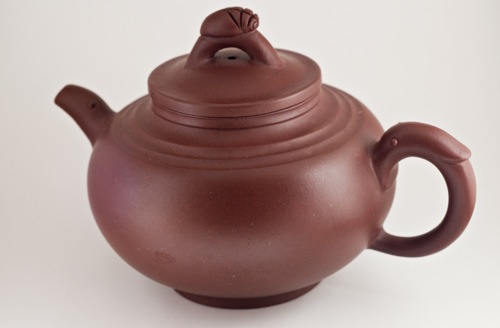
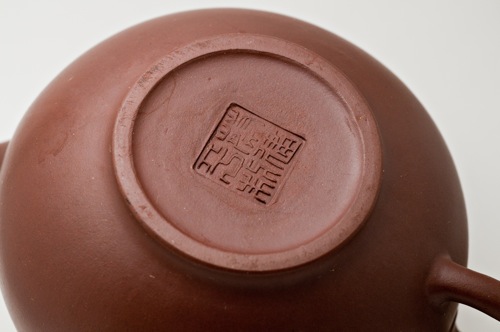
The glass teapot
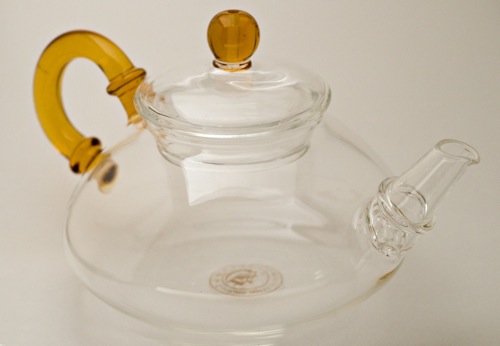
The glass gaiwan
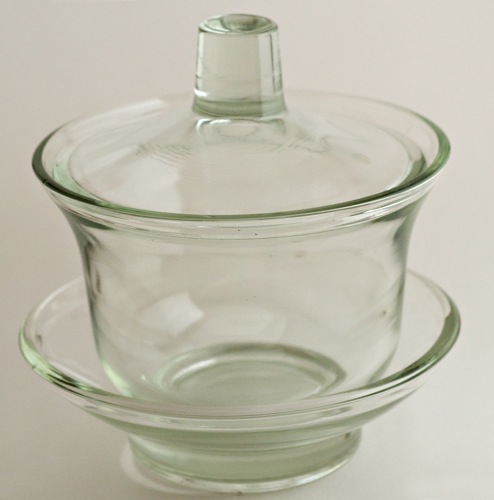
The ceramic gaiwan

and the cute porcelain gaiwan

Have now used all but the porcelain gaiwan, and the glass teapot, and am slowly figuring the gaiwan out.
-
Lot of clicks for what should be a simple job, but here is the pot in question:


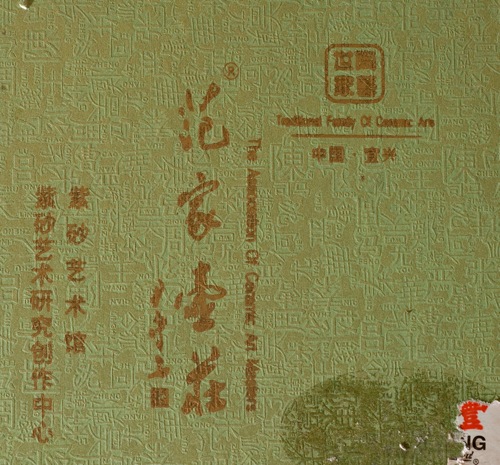
The box--again, not sure if that is specific to this pot or not--says in english 'association of ceramic arts masters' and 'traditional family of ceramic arts'.
-
My tasting notes for two different sessions follow.
I did three sessions, one with my clay teapot, one with a glass gaiwan, and a 2nd with a ceramic gaiwan. The 2nd time I forgot to rinse the leaves first, and used water that was overall hotter, and released more bitter flavors that were difficult to control.
The first and third batches were much better.
I took a set of photos of the first brewing, and they're on my flickr here:
http://www.flickr.com/photos/debunix/sets/...7202856/detail/
FIrst brewing
Set aside the tea for brewing--sorry I don't have a scale, but given that the sample was 10g, probably used about 4 grams for my pot, which is about 160 mL
Heated small clay teapot, rinsed tea, let sit 2 min before first brewing--teapot was 160 degrees exterior after first heating rinse
1st infusion 193 degrees 1 minutes sweet, floral, fresh mown hay; 2 minutes stronger odor--again, sweet, floral, new mown hay, vegetal/steamed fresh asparagus, caramel; warmer and stronger but still the same
Much more like pouchong than the ti kuan yin
then 2nd infusion 198 degrees 3 minutes
deeper gold, stronger notes of hay and caramel, less floral odor, but stronger grassy/vegetal notes in the actual infusion, hint of bitterness but only enough to ground the flavors, like SB 70% vs some of the flatter single-origin criollos
3rd infusion, let the water in the pot cool, was 177 for final infusion of 4 minutes--more like the first infusion in being lighter, faintest hint of bitter, but much less floral, but still quite sweet
(amazed at how the bitter flavors came out a bit with the hotter water in the 2nd infusion but were not still right there in the 3rd infusion)
4th infusion 3 minutes, forgot to take temperature, odor is much weaker, but otherwise unchanged in character; richer color; more straw flavor; some vegetal bitterness in last swallows; will stop here
leaves now smell bitter and unpleasant, and did before this brewing as well, but the tea never was
packs a powerful caffeine punch after the entire brewing x 4 small pots
3rd brewing
heated gaiwan, rinsed the rest, maybe 3 grams of leaves, 20 seconds 195 degrees
30 seconds with 195 degrees full gaiwan: sweet, floral, lighter hay undertones
1 minute with 195 degrees gaiwan: a touch of bitter with the same overall aroma and presence
2 minutes with 195 degrees in gaiwan: more bitter, still lovely aroma
1 minutes with 185 degrees in gaiwan: light, almost too light, but the bitter is gone
1 minutes with 193 degrees in gaiwan: light, but lovely
I think the key is the shorter brewing time and milder temps that bring out the sweet and floral and hay with a minimum of bitter
And the tea may have a bit more to give, if I did worked with gentler longer infusions, but I do not have more time tonight!
I will order some of this tea shortly.
-
Yes, I know Wing Hop Fung. I have bought a few tea canisters on their website. Do they have more tea and tea-things in the store than on the site, as most b&m stores with a website do?
They have a tea tasting are with about 50 different teas in bulk, and that might be an underestimate, plus many tinned teas, pu-erh cakes in plain wraps and fancy packages, and a large selection of teaware--relatively few gaiwans in simple styles, quite inexpensive, and lots and lots of the small pots like mine, though most were more decorated, may fancier presentation sets and lots of japanese cast iron pots, and more. It is quite amazing.
And my little pot holds about 160 mL.



Traveling with tea
in Coffee & Tea
Posted
I do have a nice little lexan mug--light and sturdy--and a spare wire mesh infuser that also should be pretty sturdy.
Just would like a smaller electric kettle, and I'll be all set.